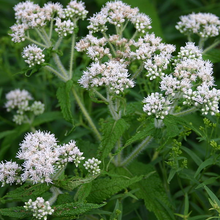Eupatorium perfoliatum is a tall clump forming perennial recognized by its distinctive perfoliate leaves where each stem appears to pierce through the leaf base. Clusters of fuzzy white flowers bloom in late summer atop sturdy stems, lending a soft glow to wetland edges and naturalized plantings. Historically known as "boneset," it was widely used in traditional medicine for fevers and flu. Its late bloom time and structure make it a vital resource in the seasonal transition from summer to fall.
Height & Spread: 36 - 60 in x 24 - 36 in
Bloom Time: July to September
Light Requirements: Full sun to part shade
Soil Preference: Moist to wet soils, including clay and loam
Watering Needs: Moderate to high; prefers consistent moisture
Deer Resistance: Moderately deer resistant
Native Status
This species is native to eastern and central North America, commonly found in moist meadows, low woodlands, marshes, and stream banks.
WILDLIFE & INSECTS
Butterflies
- Attracts a wide variety of butterflies such as Monarch, Painted Lady, and Pearl Crescent, which visit its dense late season flower clusters for nectar.
Bees
- Visited by native bumblebees, small carpenter bees, and sweat bees that forage heavily on its abundant nectar.
Moths
- Supports nocturnal pollinators including species such as the Eupatorium Borer Moth and the Ruby Tiger Moth.
Birds
- Goldfinches and sparrows occasionally feed on its seeds in fall while the tall stems provide cover and perching habitat for songbirds.
Spacing & Landscape Use
Spacing Recommendations
- Space 24 - 36 in apart to allow airflow and prevent flopping especially in moist and nutrient rich soils.
Landscape Placement
- Ideal for rain gardens, native wetland restorations, and naturalized borders where its height and bloom timing contribute vertical interest and pollinator support.
Companion Plants
- Carex vulpinoidea (Fox Sedge) - Adds fine textured grassy form at the base of boneset in moist habitats.
- Monarda fistulosa (Wild Bergamot) - Offers lavender flowers and aromatic foliage that complement boneset in wet to medium soils.
- Rudbeckia laciniata (Cutleaf Coneflower) - Provides tall golden blooms that contrast beautifully with Eupatorium’s white clusters.
- Vernonia noveboracensis (New York Ironweed) - Adds deep purple vertical accents and overlaps in bloom season with boneset.
- Eutrochium purpureum (Sweet Joe Pye Weed) - Features large mauve flower heads and pairs well in naturalistic wetland plantings.
- Actaea racemosa (Black Cohosh) - Brings late blooming white spires and a woodland edge texture that contrasts with boneset's open habit.



